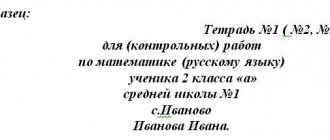Silhouette and style of clothing. presentation for a technology lesson (grade 7) on the topic
Slide 1
SILHOUETTE AND STYLE IN CLOTHING Author Lebedeva Larisa Georgievna technology teacher MBOU Secondary School No. 1 L L
Slide 2
Objective of lesson 2 To get acquainted with the history of fashion To become familiar with the concepts of silhouette and style in clothing To learn to identify clothing styles To get acquainted with famous fashion designers of the world L L
Slide 3
A little history 3 As the great Coco Chanel said: “Fashion is capricious and changeable.” Fashion is what is most popular and accepted by the majority at a certain time. The history of clothing from ancient times to the present day is like a mirror in which the entire history of mankind is reflected. Each country, each people, in certain periods of its development, leaves its mark, its specific features on people’s clothing. The history of fashion is almost as old as the history of costume. From the moment when man discovered the significance of clothing as a means of protection from the adverse effects of nature, it was not long until he began to think about its aesthetic and stylizing function. L L
Slide 4
Clothing of Ancient Greece 4 Costume in Ancient Greece developed in close connection with the living conditions of the Greeks and under the influence of their aesthetic ideas. Creating a costume, makeup, accessories was the same creation as all forms of art. Five features distinguished ancient Greek clothing: organization, regularity, proportionality, expediency and symmetry. Women wore a long tunic. The female figure in the Doric, the most ancient, chiton resembled a Doric column.. L L
Slide 5
Ancient Egypt 5 The history of Egyptian fashion is closely connected with the religion and cultural values of one of the oldest civilizations in the world - Ancient Egypt! Linen is the main material used to make new clothes. Snow-white skhenti made of fabric, which was wrapped around the hips and secured at the waist with a belt, was decorated with various ethnic patterns. The ideal of female beauty in Egypt was a tall and thin Egyptian woman with a thin waist and broad shoulders. L L
Slide 6
Medieval Europe 6 In early periods, women wore two tunics at the same time: a lower one, long and wide, with long narrow sleeves, and an upper one, shorter, with short wide sleeves. Colored stripes of trim and embroidery were located along the neckline, bottom of the product and the bottom of the sleeves. The amice is found in many types of medieval clothing, men's and women's. This is a rectangular or oval piece of fabric, folded along the shoulder line, with a slit for the head, not sewn on the sides. Different lengths and wearing styles add variety to this type of clothing. L L
Slide 7
Silhouettes of clothing Despite all the originality and uniqueness of costumes from different eras, the silhouette can be fit into one of the simple geometric shapes - a rectangle, trapezoid, triangle, oval. 7 Over the past decades, four main silhouettes can be distinguished constantly in fashion: straight, semi-fitting, adjacent (fitted), extended (trapezoid) L L
Slide 8
“Everything in a person should be beautiful: soul, face, and thoughts” A.P. Chekhov 8 Silhouette is a French word that refers to the external outline of any object, its “shadow”. Despite all the originality and uniqueness of costumes from different eras, they can be fit into one of the simple geometric shapes - a rectangle, trapezoid, triangle, oval. Over the past decades, four silhouettes can be distinguished constantly in fashion: a semi-adjacent b straight c adjacent d extended L L
Slide 9
Straight silhouette 9 Semi-fitted silhouette The semi-fitted silhouette slightly emphasizes the shape of the figure. It is characterized by a softer fit along the chest line than in the fitted version, a loose fit in the waist and hips, a calm expansion downwards, sometimes barely noticeable.. It is characterized by the same width of the product along the shoulder, chest, waist, hips and bottom. Clothes of this silhouette seem to fit into a rectangle L L
Slide 10
10 Fitted silhouette Products in this silhouette are characterized by a snug fit at the waist. At the same time, the volume of the upper part of the product can be different - from tight-fitting, repeating the shape of the body, to very loose. The close-fitting silhouette is characterized by maximum fit of the product in the chest, waist and hips. In this case, the waist line can be emphasized by darts or a belt. The fit of the back part of the product is achieved by raised seams and darts. L L
Slide 11
11 The extended silhouette resembles a trapezoid shape. It is characterized by a small volume of the upper part of the clothing (tight fit in the chest area and very wide expansion at the bottom). A-line clothing suits almost everyone. A trapezoid is a decorative silhouette, the lines of which diverge towards the bottom, distracting attention from the natural shape of the figure and helping to correct it. Therefore, this silhouette will help hide imperfections in the waist and hips. L L
Slide 12
12 To make it easier to choose clothes, female figures were divided into types: triangle, inverted triangle, rectangle, hourglass, oval. Knowing your body type makes it much easier to choose your wardrobe. A stylish woman not only follows the latest fashion trends, but also always knows the pros and cons of her figure, and which styles suit her best. Main types of female figure L L
Slide 13
13 Determine your body type L L
Slide 14
Clothing styles 14 Lat style. stilus is a stable, specifically defined language of an era, expressing its culture, the concept of beauty, and attitude towards the surrounding world. Style is a way of dressing. Clothing in nature can be businesslike, elegant, casually sporty. The nature of clothing depends on the style. There are three main styles: classic, romantic, sporty. L L
Slide 15
Classic style 15 K classic is the standard of all styles. This is a time-tested style that seems to exist outside of time. It is always relevant and appropriate almost everywhere - and this is its main difference from all other styles. The classic style has no clear age boundaries, it suits everyone: from schoolchildren to pensioners. Characteristic features of the style are: simplicity and elegance luxury and excellent quality of products no ruffles, sequins formal dresses, structured suits elegant beautiful shoes minimum accessories L L
Slide 16
Romantic style 16 This style represents elegant, extravagant clothing that emphasizes femininity and charm. His style is characterized by various finishes: flounces, ruffles, frills, lace, embroidery. The cut lines are smooth, soft and light. Elements of national (folklore) costume can also be used here. The clothes are subtly complemented with jewelry. The fabrics used are airy, shiny, flowing. More often elegant dresses and blouses are sewn in this style. L L
Slide 17
Sports style 17 Sports style of clothing is considered perhaps the most popular. This is not only clothing for sports, it is also clothing suitable for everyday wear. The requirements for sports-style clothing are the same as those typical for athletes’ clothing. Convenience, first of all, nothing should restrict movement, simplicity of style, absence of unnecessary details. The sports style of clothing is best suited for teenagers, girls and boys leading an active lifestyle. Such clothes are well suited for relaxation, country hikes, walks, sports, and can also be used as home clothes. . L L
Slide 18
Folklore style 18 A style inspired by folk art is folklore, one of those links that connect the past with the present and the future. Folklore style is a variety of embroidery and decoration, bright, clean colors. His arsenal includes rustic skirts with frills and flounces, blouses with embroidery, vests and knitted sweaters, sheepskin coats and boots, multi-colored scarves and long scarves. Modern folklore clothing style uses elements of the national costume. Used for finishing products: embroidery, hemstitching, lace, ruffles, lacing, weaving L L
Slide 19
Denim style 19 Today, the denim clothing style is so rooted in world fashion that it can be safely called one of the most relevant and fashionable styles in the world. Jeans have spread all over the world, they are worn by people of all ages, from those who cannot walk yet to those who have difficulty walking. What is it that attracts everyone so much to clothes that were originally intended as work clothes? The peculiarities of the denim clothing style are its practicality and at the same time simplicity. The denim style is considered the most reliable option of all time. However, it is always worth remembering that this style is still unacceptable for negotiations and business meetings. L L
Slide 20
20 Famous fashion designers in the world Christian Dior is a French clothing designer. Born: January 21, 1905, Granville, France Died: October 23, 1957, Montecatini Terme, Italy Education: Institute of Political Studies (Par Pierre Cardin - French fashion designer of Italian origin. One of the most influential in the history of haute couture. Since 1947 worked for Christian Dior for a year, founded his own fashion house in 1950. Born: July 2, 1922 (91 years old), San Biagio di Callalta, Italy L L
Slide 21
21 Jean-Paul Gaultier is a French fashion designer who largely determined the look of high fashion in the 1980s and 1990s, the president of his own fashion house and the company Jean Paul Gaultier SA Wikipedia Born: April 24, 1952 (61 years old), Arceuil, France Songs: How to Do That Giorgio Armani - Italian fashion designer Wikipedia Born: July 11, 1934 (79 years old), Piacenza, Italy Height Education: University of Milan, University of Bologna L L
Slide 22
22 Vyacheslav Mikhailovich Zaitsev is a Soviet and Russian fashion designer, painter and graphic artist, professor. Full member of the Russian Academy of Arts. People's Artist of Russia. Laureate of the State Prize of Russia. Born: March 2, 1938 (75 years old), Ivanovo Education: Ivanovo State University of Chemical Technology (1952–1956) L L
Slide 23
23 Valentin Abramovich Yudashkin is a Soviet and Russian fashion designer. People's Artist of Russia. Born: October 14, 1963 (50 years old), Moscow region L L
Slide 24
Literature used 24 Pushkareva N. L. Women of Ancient Rus'. M., “Thought”, I999. Orlova L. ABC of fashion - Moscow. "Education". 1988 Stepanova Yu. V. Old Russian costume according to written and archaeological sources of the X-XV centuries // Ancient Rus'. Questions of medieval studies - 2010. I. Trubetskova, N. Naydenskaya - Fashion. Color. Style. EXMO - 2011 Internet resources https://www.ukazka.ru/product-book1070167.html https://www.ayaganga.ru/costumehistory.htm https://gorod.crimea.edu/librari/ist_cost/ https:/ /dnevnik.bigmir.net/article/359590/ https://www.history-ryazan.ru/node/368?page=0.1 L L
Silhouette and style of clothing. Requirements for clothing 12/12/2007. - presentation
Silhouette and style of clothing. Clothing requirements
Types of figures
Unstable trapezoid The shoulders are quite wider than the hips, and the waist is not clearly defined. Dresses with an a-line silhouette, a dress with a loop at the neck, a one-shoulder dress, or an empire style dress are suitable. Dresses with a waist at the hips are perfect.
Stable trapezoid The hips are quite wider than the shoulders. A dress with puffed sleeves, a waist under the bust, or a dress sewn on the bias is suitable. Dresses with a V-neck will visually enlarge your bust and broaden your shoulders. A dress with a low waistline, a small tight top and a voluminous, flared bottom is not recommended for you.
Hourglass Shoulders and hips are the same width, and the waist is quite pronounced. Dresses fitted or with a belt at the waist, flared and tapered hems are suitable. The main rule for you is a fixed waist line.
Rectangle The hips are the same as the shoulders and the waist is not pronounced. Straight dresses with a low waistline in the style of the 20s and dresses with an a-line silhouette in the style of the 60s are suitable. A dress with a straight silhouette will highlight your figure well. Choose a semi-fitted silhouette of clothing, or with a belt. Dresses with a fitted silhouette are not recommended for you
The emergence of clothing
Silhouette (French word) is a planar, contour image of three-dimensional forms of clothing.
The straight silhouette fits well on almost all body shapes. The width of the product is the same along the chest and hips. The semi-fitted silhouette subtly accentuates your figure. In this case, clothes can be short or longer. The fitted silhouette is created by an extended shoulder line, hem and a narrowed waist. Trapezoidal or loose silhouette. The expansion occurs from the shoulder line or armhole to the bottom of the product. The expansion can be quiet or more significant.
Style is a stable, specifically defined artistic language of an era, in which it reflects its culture, economic situation, concept of beauty and attitude towards the world around it.
CLASSIC STYLE Characterized by emphasized severity and smartness. The clothes correspond to the natural shape of the human figure, are simple and elegant. There are very few details in such clothes and only the necessary ones: a turn-down or English collar, welt pockets with a leaf, a flap, with processing into a frame, there is almost no finishing.
SPORTS STYLE Loose-fitting clothing that provides ease of movement emphasizes the athleticism of a person’s figure, slimness and fit. Various sleeve cuts. The sporty style is distinguished by an abundance of details. Collars of various shapes
ROMANTIC STYLE It is distinguished by its complex cut, unusual shapes, and elegant finishing. For decoration, various carved lines, symmetrical and asymmetrical cuts, and drapery are used. Collars are very different: capes, hooded collars, draped ones. Flounces, ruffles, and moldings are also details of feminine style.
Connects the past of our people with the present and future. (national costume) Emphasizes dignity, elegance, sophistication. Variety of embroidery and decoration, bright clean colors. FOLK STYLE
CLOTHING REQUIREMENTS Hygienic requirements Aesthetic requirements Performance requirements Economic requirements



